


![]() FORCES ON MOVING CHARGES - cont'd
FORCES ON MOVING CHARGES - cont'd
![]()
![]()
Can magnetic fields be used to accelerate charged particles?
When we discussed the Lorentz force earlier we stated that no acceleration took place in the sense that the magnitude of the velocity of the charged particle was increased, it was only the direction of the velocity that was affected. However, if we can increase the magnitude of the magnetic field as seen by the particles in a temporal way, then the energy of the particles can be increased.
For example, if we took our magnetic bottle and arranged a system whereby the mirror points of the bottle got closer and closer together, then each charged particle is reflecting off a region whose velocity is changing with respect to its own. As a consequence the translational velocity of the particles is increased but not this time at the expense of the "gyrovelocity"; hence the particle is accelerated.
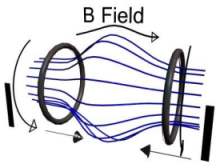
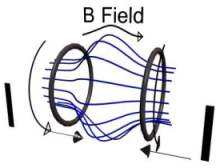
IMAGE - A magnetic bottle which could be used to accelerate charged particles.
The two pictures show the magnetic bottle mirrors moving. As they do, the magnetic field becomes more intense and as a consequence energy is transferred to the charged particles.
There is another piece of physics which also tells us of this outcome. When, in a region, there exists a magnetic field which is changing an electric field is generated (Faradays Law). We know that electric field produce forces on charged particles which accelerate them in the sense that their energy is indeed changed
![]()
How can we use a constant magnetic field to produce a changing magnetic field?
Changing, in this context, means changing with time; we have to introduce something that is moving.
Let us return to the Earth's magnetic field.
Essentially the Earth's field is a dipole field whose axis is aligned with the Earth's spin axis. However, as we saw above, this dipole field is distorted by the magnetic field of the solar wind. The dipole field is a bit stronger on the dayside and a little weaker on the nightside in comparison with the undistorted dipole field. Hence a given field line changes its geometry as the Earth rotates being closer to the Earth in daytime and further away at night time and this field line finds itself in a stronger field on the dayside and a weaker field on the nightside. But the charged particles are trapped on the field lines; hence they experience a diurnally changing magnetic field as they are swept round in the Earth's field. This is one of the reasons why there are induced electric fields in the Earth's upper atmosphere which can accelerate the particles.
Another way of achieving our objective is to have an undistorted dipole field whose axis is not aligned with the axis of a spinning body. Again, the magnetic field lines are being moved around in absolute space as a consequence of the rotational motion of the body.
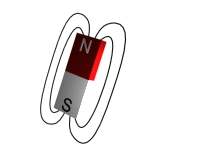
ANIMATION - A magnet whose magnetic field is off-axis.
This picture shows us one way of using a constant magnetic field to produce a changing magnetic field.
Please move mouse over image.
![]()
How can this mechanism produce large accelerations?
Faraday's law tells us that the magnitude of the induced electric field depends on the rate of change of the magnetic flux. That is to say, the more flux lines that are changed in as short a period as possible the greater the electric field. So, if we want to ensure that such accelerations are significant we need a strong magnetic field which is changing very quickly or, say, a body with a strong magnetic field which is rotating very rapidly.
Astrophysics provides us with such a body; a neutron star. It is what is called a collapsed star and is believed to be a star whose magnetic axis and spin axis are not aligned.
As a star (such as our Sun) collapses, both angular momentum and magnetic flux are conserved; that is to say as the star gets smaller it rotates more rapidly and its magnetic field increases. These are just the requirements we are looking for. The final magnitudes of these parameters simply depends on how far the star collapses.
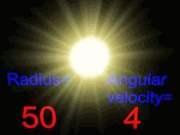
(1) |
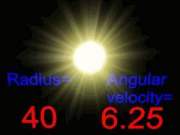
(2) |
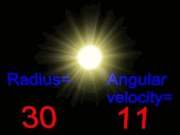
(3) |
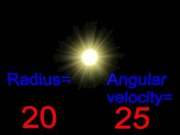
(4) |

(5) |
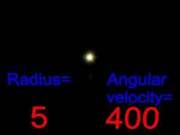
(6) |
IMAGE - Six images showing how angular velocity changes with the radius of a collapsing star (units are arbitary).
It can be shown that for a spherical volume, angular velocity is inversely proportional to the square of the radius. Please note that the radius is to the left and the angular velocity is to the right of the pictures.
Neutron stars (which are typically of the same mass of the Sun) are typically only 10 km in diameter. They can spin up to about 30 times a second and have magnetic field strengths that are about 108 T. See if you can verify this approximately from your knowledge of the Sun. Click here for answer.
![]()
What is a pulsar?
If we have a spinning neutron star as we have just described, it will have in its atmosphere charged particles which are trapped in its magnetic field. Hence these accelerated charged particles produce electromagnetic radiation which is beamed outwards along the axis of the magnetic field. Since the direction of this beam precesses in space as a result of the rotation of the star, an observer may find himself aligned with the beam momentarily as the beam sweeps through that direction. The radiation will appear again to the observer when the beam has come through a complete cycle of rotation. Hence the source appears to pulsate with the rotation frequency of the spinning star. Hence the pulsar.
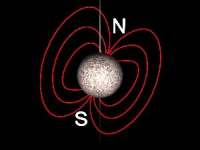
IMAGE - A neutron star with its magnetic field.
Please move mouse over image.
This apparent "coding" of the light beam was initially thought to be evidence of another civilisation attempting to communicate but is now seen to be a natural phenomena which can occur during the normal life cycle of a star.
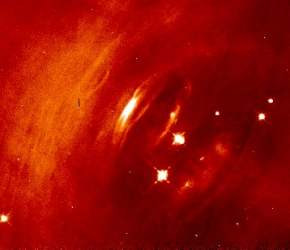
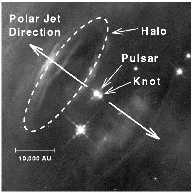
IMAGE - The M1 pulsar in the Crab Nebula - courtesy of NASA.
The image on the left was taken with the Hubble Telescope and you can easily see the effects of the radiation being emitted towards the top left and bottom right. The radiation ionizes the stellar gas which reradiates. What we see are the two halos as shown in the righthandside picture.
![]()
What is synchrotron radiation?
Pulsars are often detected within vast clouds of gas which are also emitting continuum radiation over a wide range of frequencies. These clouds are known as supernovae remnants. The spectrum of the light from such sources is not the same as that emitted by, for example, the Sun. The Sun emits radiation which is characteristic of a body in thermal equilibrium and is known as blackbody radiation. The blackbody spectrum has a peak in it which is related to the temperature of the blackbody. The synchrotron spectrum has no such peak; it is simply a line representing a diminishing intensity with increasing photon frequency. Such radiation is characteristic of very energetic charged particles which are moving close to the velocity of light in regions where there are magnetic fields.
The mechanism by which particles can be accelerated to such exotic speeds is one that has its basis in the process described above. The magnetic field is that which is associated with the remnant itself.
It is thought that in the final stages of the evolution of some stars there is a very rapid collapse in which much of the mass of the collapsing star is compacted into a neutron star and the remainder of the mass is spewed into space in a huge explosion and energy dissipated. When this expanding gas collides with the material in interstellar space, shocks are established which can produce ionisation. These locally produced charged particles will emit radiation as we have described. However, synchrotron radiation is seen throughout the cloud, not only in the shock fronts. Hence there has to be a mechanism which keeps energy pumped into the whole of the cloud.
Calculations show that the source of the energy is the rotating neutron star at the centre of this vast cloud; indeed careful measurements show the neutron stars to be slowing down in their rotation at just the right rate to account for the photon energy output from the supernova remnant.
Are there any other sources of synchrotron radiation besides supernovae remnants?
We have said that magnetic fields are present wherever there are moving charged particles. Hence they permeate the regions where there are stars. Wherever there are also sources of large amounts of energy then in principle such charged particles can be accelerated to velocities close to the speed of light. Thus such regions should emit synchrotron radiation.
Another class of objects which falls into this category is the active galaxy. At the more energetic end of such galaxy classification is the quasar. Quasars emit enormous amounts of synchrotron.
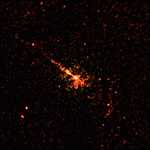
X-ray |
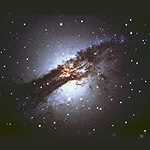
Visible (optical) |
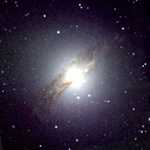
Infrared |

Radio |
IMAGE - Four images of Centaurus A which is an active galaxy - courtesy of Harvard University America and Chandra NASA.
The four images were taken in different parts of the electromagnetic spectrum. The x-ray image shows the bright source of the galaxy and many believe it to be a super-massive blackhole. The visible and the infrared pictures shows the dust surrounding the galaxy and the radio picture indicates there are two jets of radiation being emitted from the centre of the galaxy.
![]()
What is the source of energy in quasars?
By studying the timescale on which the synchrotron radiation can vary gives an indication as to the physical extent of the emitting region. Even though quasars are known to be galaxies, the size of the region which is actually responsible for the vast amount of energy production is similar to the size of our solar system. The amounts of energy are very much greater than can be produced by collapsed objects such as neutron stars.
However, if a neutron star collapses further it becomes a black hole. Hence it is thought that the engine at the centre of quasars must be super-massive black holes. The event horizon (or Schwarzschild radius) of a 108 solar mass black hole is of the order of a few astronomical units; that is typically the size of (or less than) a planetary system. Try calculating this result for yourself.
So the basic source of energy is accepted as being a super-massive blackhole into which stars fall. It is not known which comes first, the galaxy or the black hole. However, since the black hole "feeds" off the stars in its neighbourhood, at some stage it will run out of "food" and so its source of energy will dry up. This is why quasars tend to be seen more at larger cosmological distances than locally since we are looking at them when they were considerably younger. It is thought that our own Galaxy has a defunct black hole at its centre.
Super-massive black holes can be re-ignited during collisions between galaxies whereby new gas and stars brought in by the colliding galaxy can be consumed by the black hole.
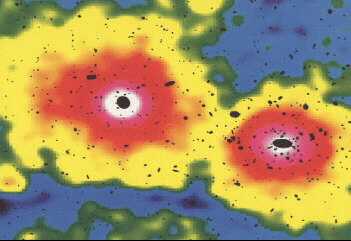
IMAGE - A computer simulation of two galaxies colliding - courtesy of ESA.
A collision between two galaxies would re-ignite black holes.

